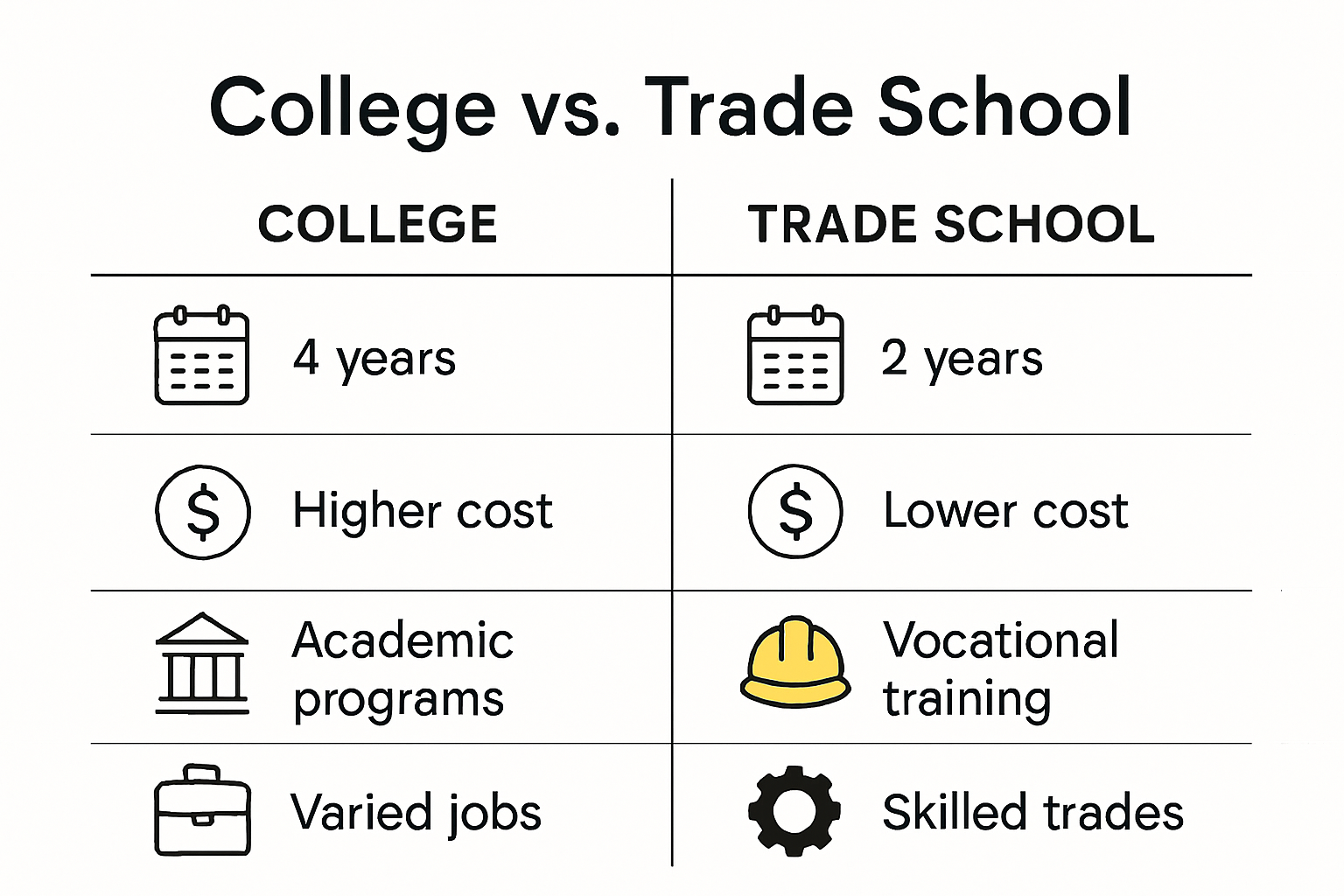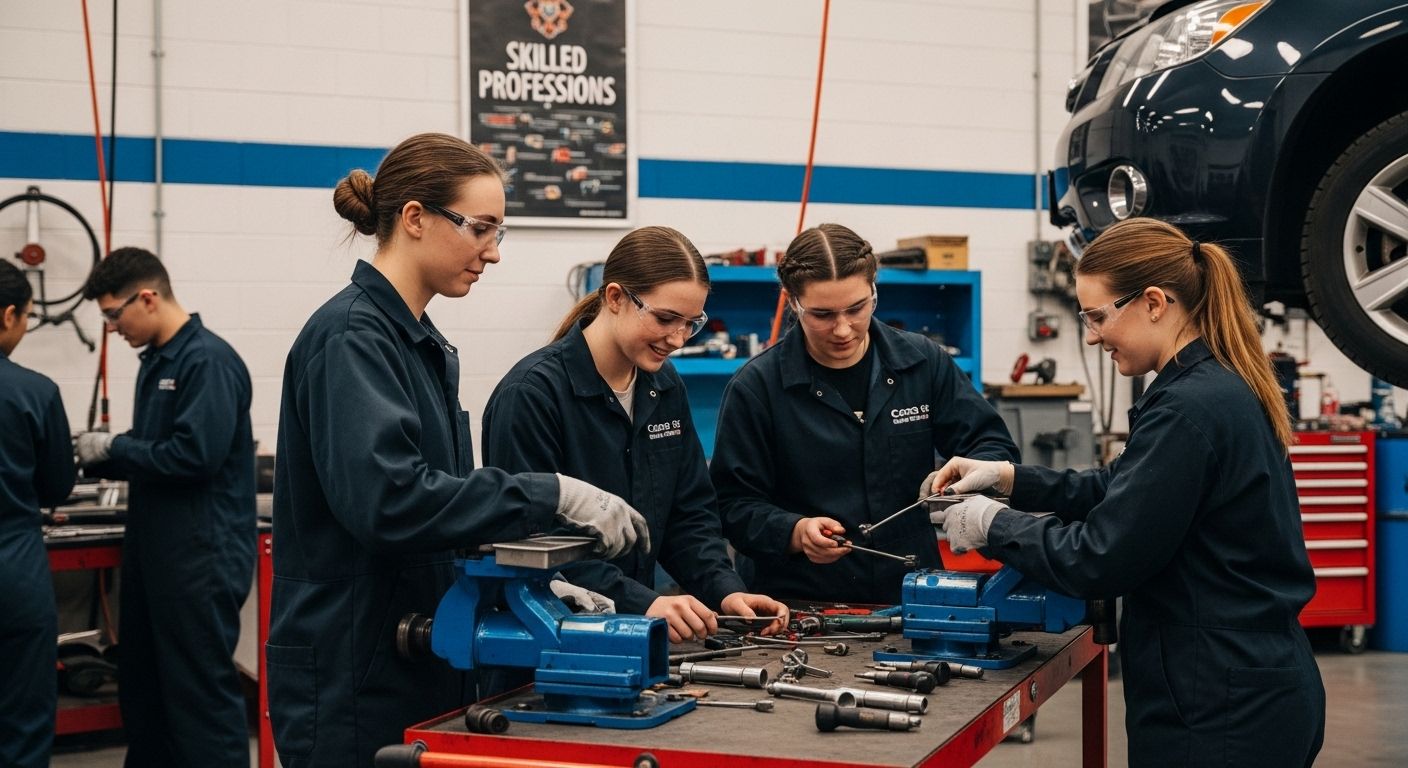
Trade schools are proving to be a smart alternative for anyone who wants a hands-on career without spending years in a traditional college setting. Think of this: trade school programs can often be finished in just 6 to 24 months, which is a fraction of the time it takes to earn a typical four-year degree. Most people assume that faster means sacrificing quality or opportunities. The reality is these programs are carefully designed to match exactly what growing industries need, setting up students for well-paying, in-demand jobs faster than most expect.
Table of Contents
- Understanding The Different Types Of Trade Schools
- Popular Trades And Programs For Skilled Workers
- Choosing The Best Trade School For Your Career Goals
- Trade School Benefits For Blue-Collar Professionals
Quick Summary
| Takeaway | Explanation |
|---|---|
| Trade schools offer targeted career training. | These institutions provide practical education tailored to meet the specific needs of various industries. |
| Programs typically require 6-24 months. | Trade school training often takes less time than traditional degrees, allowing for quicker entry into the workforce. |
| Research is essential in choosing a trade school. | Evaluating program accreditation, curriculum, and support services is crucial for making informed decisions about your education. |
| Hands-on training prepares for in-demand jobs. | The focus on real-world skills equips students to excel in critical fields like healthcare, manufacturing, and technical trades. |
| Lower costs make trade schools financially accessible. | Trade schools generally offer more affordable tuition compared to four-year universities, making education more attainable for many students. |
Understanding the Different Types of Trade Schools
Trade schools represent a powerful pathway for individuals seeking specialized career training outside traditional four-year college routes. These institutions provide targeted education that transforms practical skills into professional opportunities across multiple industries.
Categories of Trade School Programs
Trade schools are not a one-size-fits-all educational model. They offer diverse programs designed to meet specific workforce demands. The National Center for Education Statistics reports that approximately 16% of postsecondary students are enrolled in career and technical education programs, highlighting the significant role these institutions play in workforce development.
The primary categories of trade schools typically include:
- Technical Institutes: Focused on hands-on training in technology-driven fields such as computer networking, automotive technology, and electronics repair
- Vocational Schools: Providing comprehensive training for skilled trades like plumbing, electrical work, and construction
To help readers quickly compare the major types of trade school programs highlighted, the following table summarizes their focus areas and common training subjects.
| Type of Institution | Focus Area | Common Programs |
|---|---|---|
| Technical Institutes | Technology-driven hands-on training | Computer networking, automotive tech, electronics |
| Vocational Schools | Skilled trades for infrastructure | Plumbing, electrical work, construction |
Specialized Training Environments
Unlike traditional academic settings, trade schools prioritize practical skill development. Bureau of Labor Statistics research indicates that many trade school programs can be completed in 6-24 months, significantly shorter than traditional four-year degree paths. This accelerated learning model allows students to enter the workforce quickly with industry-recognized credentials.
These educational institutions are strategically designed to bridge the gap between classroom learning and real-world application. Students engage in hands-on training that simulates actual workplace environments, ensuring they develop not just technical skills but also professional competencies required in their chosen trades.
The diversity of trade school programs reflects the complex needs of modern industries. From welding and HVAC technology to healthcare support roles and culinary arts, these institutions offer targeted pathways for individuals seeking meaningful careers that do not necessarily require a traditional four-year college degree.
Understanding the nuanced landscape of trade schools empowers students to make informed decisions about their professional futures. By recognizing the variety of programs available, individuals can select educational paths that align precisely with their career aspirations and personal strengths.
Popular Trades and Programs for Skilled Workers
Skilled trades represent a robust and dynamic career pathway for individuals seeking meaningful work with hands-on expertise. The landscape of trade school programs continues to evolve, reflecting the changing demands of modern industries and technological advancements.
Diverse Career Training Programs
The Association for Career and Technical Education highlights several major trade areas that offer promising career opportunities. These programs are strategically designed to prepare workers for high-demand sectors that require specialized technical skills.
Key trade programs include:
- Construction Trades: Carpentry, masonry, electrical work, and plumbing represent core skills in building and infrastructure development
- Manufacturing Specialties: Machining, welding, and advanced manufacturing technologies provide critical workforce capabilities
- Transportation Technologies: Automotive repair, aviation mechanics, and diesel engine maintenance offer robust career paths
In-Demand Skilled Professions
The National Center for Education Statistics reports that certain trade programs consistently demonstrate strong employment potential. Healthcare support, precision production, and transportation sectors continue to be primary sources of skilled worker training.
Professional trade programs go beyond simple job training. They represent comprehensive educational experiences that transform raw talent into specialized professional expertise. Students learn not just technical skills but also critical problem-solving abilities, safety protocols, and industry-specific best practices.
The automotive technology sector, for instance, now requires workers who can navigate complex computer systems and advanced diagnostic technologies. Modern welding programs integrate computer-aided design and precision manufacturing techniques, demonstrating how traditional trades continuously adapt to technological innovations.
Healthcare support roles have also expanded dramatically. Specialized training programs now prepare students for roles like medical laboratory technicians, radiology support specialists, and advanced nursing assistants. These programs offer accelerated pathways into critical healthcare infrastructure.
For those interested in exploring career-ready workwear that matches these dynamic trades, learn more about professional trade apparel that supports hardworking professionals across multiple industries.
The modern trade school landscape represents more than job training. It is a comprehensive ecosystem of professional development, technological adaptation, and skill mastery that empowers individuals to build meaningful, sustainable careers in hands-on industries.
Choosing the Best Trade School for Your Career Goals
Selecting the right trade school is a critical decision that can significantly impact your professional trajectory. The process requires careful consideration of multiple factors beyond simple program availability, including personal career aspirations, financial resources, and long-term industry opportunities.
Key Factors in Trade School Selection
Federal Student Aid guidelines recommend comprehensive research when evaluating potential trade school programs. Students should assess multiple dimensions to ensure their educational investment aligns with career objectives.
Critical evaluation criteria include:
- Program Accreditation: Verify institutional and program-specific credentials that validate educational quality
- Curriculum Alignment: Ensure course offerings match current industry technological and skill requirements
- Career Support Services: Investigate job placement rates, internship opportunities, and professional networking resources
The section below outlines the critical criteria recommended when selecting a trade school, helping prospective students evaluate their options more effectively.
| Evaluation Criteria | Description |
|---|---|
| Program Accreditation | Validates quality through institutional and program-specific credentials |
| Curriculum Alignment | Ensures courses meet current industry and technology requirements |
| Career Support Services | Includes job placement rates, internship opportunities, and networking resources |
| Program Cost & Financial Aid | Analyze total program costs and available financial assistance |
| Geographic Location | Considers job market strength and local industry connections in the region |
Financial and Career Planning Considerations
Beyond academic curriculum, prospective students must carefully analyze the financial and practical aspects of trade school enrollment. The U.S. Department of Education emphasizes the importance of understanding total program costs, potential financial aid options, and projected return on educational investment.
Successful trade school selection involves strategic planning that goes beyond immediate training. Students should conduct thorough research about potential earning potential, industry growth projections, and specific skill demands within their chosen trade.
Modern trade schools increasingly offer specialized programs that integrate technological training with traditional hands-on skills. For instance, automotive technology programs now incorporate advanced diagnostic computer systems, while welding courses include computer-aided design techniques. This evolution requires students to look beyond basic skill training and focus on comprehensive, future-ready educational experiences.
Geographic location can also play a significant role in trade school selection. Some regions have stronger job markets for specific trades, and local industry connections can provide valuable internship and employment opportunities. Prospective students should investigate regional economic trends and workforce demands specific to their chosen field.
For professionals seeking additional guidance on preparing for a trades career, explore career-ready workwear strategies that support both professional development and personal confidence.
Ultimately, choosing the best trade school is a personalized journey that requires self-reflection, thorough research, and alignment between individual career goals and institutional offerings. By approaching the selection process methodically and comprehensively, students can set themselves up for successful, fulfilling careers in skilled trades.
Trade School Benefits for Blue-Collar Professionals
Blue-collar professionals find trade schools to be a powerful pathway to career success, offering unique advantages that traditional academic routes cannot match. These specialized educational institutions provide targeted training that directly translates to real-world workplace skills and opportunities.
Accelerated Career Preparation
BestColleges research highlights the significant economic advantages of trade school education. Unlike four-year college programs, trade schools offer a more direct route to employment, with lower tuition costs and shorter degree pathways. Students can complete most programs in just one to two years, allowing for rapid entry into the workforce.

Key advantages for blue-collar professionals include:
- Practical Skill Development: Hands-on training that directly applies to job requirements
- Cost-Effective Education: Significantly lower tuition compared to traditional four-year degrees
- Faster Career Launch: Accelerated programs that get students working quickly
Economic and Professional Opportunities
The National Society of High School Scholars emphasizes the diverse career opportunities available through vocational training. Trade schools prepare students for critical industries including automotive technology, healthcare support, construction, culinary arts, and specialized technical roles that are essential to modern infrastructure.
The economic landscape increasingly values specialized skills over generic academic credentials. Blue-collar professionals who complete trade school programs often find themselves in high-demand fields with competitive salaries and strong job security. Many trades offer opportunities for entrepreneurship, allowing skilled workers to establish their own businesses and create additional income streams.
Technological advancements have transformed traditional blue-collar careers. Modern trade school programs now integrate advanced technologies, teaching students to work with sophisticated equipment and digital systems. This approach ensures that graduates are not just skilled workers but adaptable professionals capable of navigating complex technological environments.
For professionals looking to maximize their career potential, explore professional workwear strategies that support both professional development and workplace confidence.
The benefits extend beyond immediate career opportunities. Trade schools offer a unique educational model that values practical expertise, hands-on learning, and direct industry connections. They provide a pathway for individuals to transform their passion for skilled work into sustainable, rewarding professional careers that contribute meaningfully to society’s infrastructure and economic growth.

Ultimately, trade schools represent more than just an educational choice. They are a strategic investment in personal potential, offering blue-collar professionals a proven route to building successful, fulfilling careers with tangible skills and real-world impact.
Frequently Asked Questions
What are the main types of trade schools?
Trade schools generally fall into two main categories: technical institutes, which focus on technology-driven training in areas like computer networking and automotive technology, and vocational schools that specialize in skilled trades such as plumbing, electrical work, and construction.
How long does it typically take to complete a trade school program?
Most trade school programs can be completed in 6 to 24 months, significantly shorter than a traditional four-year degree, allowing for quicker entry into the workforce.
What are the benefits of attending a trade school?
Attending a trade school offers various benefits including targeted career training, practical skill development, lower tuition costs compared to traditional colleges, and faster career launches into high-demand fields.
How do I choose the right trade school for my career goals?
When selecting a trade school, it’s essential to evaluate factors such as program accreditation, curriculum alignment with industry needs, available career support services, total program costs, and the geographic location in relation to local job markets.
Gear Up for Success in Skilled Trades
You have put in the effort to compare trade school options and discovered how practical, hands-on training prepares you for lucrative, in-demand fields. In the trades, comfort, durability, and confidence matter as much on the job as technical skill. When you start your training or step into a new role, your workwear should match your commitment to quality and resilience.

Why settle for ordinary when you can wear gear built for true professionals? The WorkwearComfort.com collection is crafted for people who value both style and strength. Explore our range of rugged, high-function apparel — including women’s workwear and UPF 50+ hoodies — and find something that helps you train, work, and stand out. Visit WorkwearComfort.com today and build your future with apparel designed for hardworking achievers.
Recommended
- Women in the Trades 2025: Durable Workwear and Strong Careers - WorkWear Comfort
- Top Trades Gear and Apparel for 2025: Rugged Choices - WorkWear Comfort
- Best Affordable Workwear Brands for Tough Jobs 2025 - WorkWear Comfort
- What Is Workwear? A 2025 Guide for Hardworking Professionals - WorkWear Comfort






















